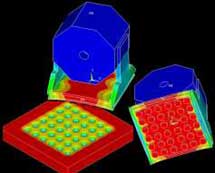
Handy Links
SLAC News Center
SLAC Today
- Subscribe
- Archives: Feb 2006-May 20, 2011
- Archives: May 23, 2011 and later
- Submit Feedback or Story Ideas
- About SLAC Today
SLAC News
Lab News
- Interactions
- Lightsources.org
- ILC NewsLine
- Int'l Science Grid This Week
- Fermilab Today
- Berkeley Lab News
- @brookhaven TODAY
- DOE Pulse
- CERN Courier
- DESY inForm
- US / LHC
SLAC Links
- Emergency
- Safety
- Policy Repository
- Site Entry Form

- Site Maps
- M & O Review
- Computing Status & Calendar
- SLAC Colloquium
- SLACspeak
- SLACspace
- SLAC Logo
- Café Menu
- Flea Market
- Web E-mail
- Marguerite Shuttle
- Discount Commuter Passes
-
Award Reporting Form
- SPIRES
- SciDoc
- Activity Groups
- Library
Stanford
Around the Bay
ILC to Support Two Complementary Detectors
 Over the last year, the ILC Global Design Effort (GDE) has concentrated on developing a complete design and cost estimate for the ILC. These designs and numbers will be released in early 2007 as part of the ILC Reference Design Report. For this report, numerous design changes have been adopted to take advantage of recent R&D results and to make the project more affordable, and more changes are yet to come.
Over the last year, the ILC Global Design Effort (GDE) has concentrated on developing a complete design and cost estimate for the ILC. These designs and numbers will be released in early 2007 as part of the ILC Reference Design Report. For this report, numerous design changes have been adopted to take advantage of recent R&D results and to make the project more affordable, and more changes are yet to come.
In the last few months, significant changes have already been approved to improve performance, reduce cost, or shorten the construction schedule. One of these was to plan for the experimental detectors to be assembled on the surface, and then lowered into the collider hall as large pre-commissioned slices. A similar scheme was adopted for the CMS detector at CERN's Large Hadron Collider and allowed major detector assembly to start years before the experimental hall was ready. Such a change has a major impact on the detector design and needed to be carefully considered by the physicists.
Another change was to make the crossing angles of the two interaction regions both 14 milliradians rather than the original design of 20 milliradians and 2 milliradians. At the same time, the two interaction regions were merged into a single experimental hall, separated transversely by some 30 meters. In this configuration, there are still separate beamlines leading to the two interaction regions with their different detectors.
In the ILC, design changes are coordinated through the GDE Change Control Board (CCB). Usually these proceed with little input from the particle physicists, however, the Beam Delivery System of the ILC is the subsystem closest to the experiments, and design changes to this area need to be closely coordinated with the experimental particle physics community. The ILC World Wide Study organization and its Machine Detector Interface subpanel represent the experimental physicists for changes under consideration. They review the proposed changes and solicit input from the community helping to decide whether the change is acceptable.
Together with a task force of detector colleagues, the Beam Delivery System group is now investigating a possibility of another radical change to the design that could save about a third of the Beam Delivery cost. This alteration would eliminate one of the beamlines altogether, and instead use a single interaction region shared by the two detectors. To make this possible, the detectors would also need to be redesigned to be mobile, allowing the detectors—only one of which will take data at a time—to exchange position several times during a one year run. This scheme is referred to as a "push-pull" arrangement.
In little more than a month, the task force has managed to evaluate a large number of technical issues, including where and how to break the vacuum connection, how to move the detector, how to design the cryogenic system so that no disconnections would be required, what is the impact on the internal alignment system, and how to speed up the whole procedure. While tentative solutions exist for many of these questions, a reliable design will require focused efforts from both the detector and accelerator sides. Finding the optimal solution is a serious challenge, but one worth the effort to preserve ILC's two complementary experimental detectors.
Click here for more information on the International Linear Collider (ILC), the Beam Delivery System (BDS) and the Global Design Efforts (GDE).
—Andrei Seryi
SLAC Today, November 30, 2006
Above image: A conceptual study of a 14-kiloton detector lifted by 36 air-pads. The induced deformation of the concrete floor are about half a millimeter, as shown by John Amann. This deformation is represented by the range of colors directly below the detector. The design goal is to ensure that moving the detector would not disturb its internal alignment. (Click on image for larger version.)